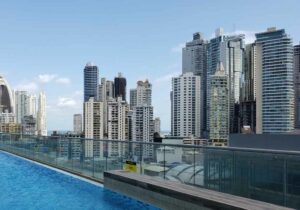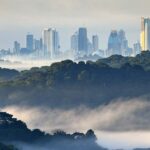Panama has long been a popular destination for many retirees, known for its great infrastructure, beautiful landscapes, and affordable cost of living. From its lush mountains and beaches to its comfortable rainy season, Panama has offered a unique appeal for those looking to relocate.
While Panama is no longer the cheapest country to live in, it still offers an attractive lifestyle with a relatively affordable cost of living compared to some neighboring countries like Costa Rica.
In this article, we’ll provide a realistic look at living in Panama today, covering the pros and cons, overall costs, and key factors to consider when planning your move.
What Is It Like Living in Panama?

Panama uses the US dollar and balboa, isolating the economy from the general instability of volatile currencies. However, living in Panama is more expensive than living in other Latin American countries. You need more than $1,100 to cover the minimum monthly expenses.
Panama offers modern infrastructure, different international cuisines, parks, and an excellent nightlife. The Panama Canal connects the capital to the Atlantic Ocean, which links the Pacific Ocean to the Caribbean Sea.
Panama City, the capital of Panama, has all the modern amenities of a cultural center. Smaller towns offer cheaper housing, food, and utilities than Panama City. Many expats and retirees may avoid city life to live in places like Boquete, Pedasí, or Santa Fe.
The weather is hot and humid most of the year, with dry and wet seasons. The rainy season lasts from May through mid-December. Late December through March is the high season, which is more crowded and expensive.
Living in Panama as an expat – what to expect?
Panama offers a familiar culture, affordable housing, simple immigration, and tax policies. Living in Panama is about 36.3 percent cheaper than in the United States. However, the salaries are lower as well. North American expats who move to the capital can lower their living expenses by up to 50 percent.
Whether your dream home is somewhere near a beach, mountain retreat, or the outskirts, you can live comfortably in Panama City for around $2,500 per month. But you may need more than $4,000 for a more lavish lifestyle.
Panama’s real estate market offers an excellent opportunity to diversify your assets. Compared to many other countries in the region, it has controlled inflation and relatively stable GDP growth.
Expats can also expect:
- Cheaper rent. The rent in Panama is about 44 percent lower than in the United States. However, the cost can vary depending on the type of accommodation and location.
- Intense rain and humidity. In the summer, humidity levels increase, mainly around the coast and river valleys. The rain comes in short, heavy bursts, often in the afternoon or evening.
- International goods and services. Large grocery stores are full of international products.
- Stunning natural beauty. There are many interesting places to go: hiking, running, mountain biking, fishing, scuba diving, and surfing. The rainforest is just a short distance away from Panama City.
Where do most expats live In Panama?
Expats often prefer to live in gated communities across the country. The choice can vary based on the type of lifestyle you choose. Many communities consider rural areas to be quieter, while places like Bocas Del Toro as excellent summer destinations for surfing, diving, and untouched natural beauty.
These locations may include:
1. Boquete
Boquete has the largest expat community in the country from North America and Europe. Established expat communities choose this town due to the friendly people, affordable healthcare costs, accessible prices, and cool temperatures.
Average rent cost: $640 to $3,000 per month
2. Panama City
The capital has a modern infrastructure and a fast-growing economy. It is very close to North America and offers a cheaper lifestyle. Living in Panama City also comes with a great view of the surrounding mountains.
You can access private hospitals, shopping malls, restaurants, private schools, and other amenities in the capital. However, you need to allocate a higher monthly budget compared to rural areas.
Average rent cost: $880 to $5,500 per month
3. Pedasí
Expats choose this location due to the urban amenities and the cultural landscape. There are many grocery stores, restaurants, and beaches. Pedasí has many rural areas, mostly countryside, with farms, ranches, and open land. Some expats and locals choose this location to live off-grid.
Average rent cost: $500 to $2,500 per month
4. Santa Fe
Santa Fe combines a relaxed lifestyle with modern living. This town is an excellent option for those who prefer remote areas. It offers many benefits, such as affordable housing, grocery stores, hiking trails, etc.
Average rent cost: $800 to $2,700 per month
5. Bocas del Toro Town
Bocas del Toro has a large expat community. The town is a tourist hub with many bars, nightclubs, and parties. Most expats live away from town, on a beach, island, or a mangrove. Tourists usually speak English and are major contributors to the local economy.
Average rent cost: $750 to $1,200 per month
What are the pros and cons of living in Panama?
Life in Panama is no paradise. Like all foreign countries, it has its own culture, financial considerations, predominant language barriers, legalities, and career challenges. So, most people need time to adapt. Here is a quick look at the pros and cons of living in Panama.
Pros to Expect
1. Affordable Rent Prices
Compared to Costa Rica, rent in Panama is cheaper, allowing expats to live on a reasonable monthly budget. For example, in Volcán, a town in the highlands of Chiriquí Province, rent can be as low as $300 per month.
2. Tax haven
Panama doesn’t tax any income you earn outside of its borders. Panama levies no tax on earnings, interest, dividends, retirement income, or capital gains that you generate outside the country. It only taxes the income you earn inside the country.
3. Low risk for extreme weather
Panama has no major hurricanes or tornados. At sea levels, daytime temperatures can range from 80°F to 90°F (27°C to 32°C). The Pacific Coast is warmer and drier, while the Caribbean Coast is more humid and rainier.
4. Good real estate potential
Prices are rising, but investments can be lucrative. Experts predict a steady growth in the real estate market due to increased tourism, canal expansion, and favorable government policies.
The Panama Citizenship by Investment program provides foreign investors with permanent residency and an opportunity to build their assets.
5. Excellent Retiree Benefits
People are considering retiring in Panama due to the large expat community, comfortable tropical climate, and impressive landscape. Resident retirees get countless discounts and benefits.
For example, you can enjoy:
- 25 percent off domestic flight tickets
- 50 percent discount on entertainment
- 20 percent reduction in medication costs
- 30 percent off on train, boat, or bus fares
- At least 10 percent discount for healthcare expenses
6. Drinkable tap water
Most areas in Panama have clean tap water. The country prioritizes safe drinking water for visitors and residents.
7. Reliable high-speed internet
Cities and popular expat zones have fast internet, making it a great choice for remote work and running an online business.
8. Versatile schooling system
International schools are more available in Panama City than anywhere else. Homeschooling is also an option.
9. Fit for any lifestyle
Although a small country, Panama provides everything from Caribbean beaches to mountain towns and farmland. Many expat communities are a great place to make friends.
10. Top quality healthcare
Hospital Punta Pacifica has state-of-the-art systems and facilities. It is the only hospital in Central America supported by Johns Hopkins International.
11. Close proximity to friends and family
Direct flights from Panama to Fort Lauderdale or Miami can take about 3 hours. Traveling to cities like New York and Houston is also reasonably quick.
Many foreigners are choosing Panama residency by investment to secure a strategic location for business and tourism in Central America.
Cons to Expect
Some expats are unhappy with cultural adjustments, urban planning, and language barriers. The significant drawbacks often include:
- Increased cost of living. The cost of living increased by $122 from 2021 to 2024. Prices are rising in urban areas, especially in the capital city. The average salary is $734, which means a person would earn $300 less than what it costs to live there.
- Unreliable public transportation system. Public transit is slow, overcrowded, and most likely to get stuck in traffic.
- Traffic jams. Traffic can come to a standstill during rush hours, around 7–9 am and 4–6 pm.
- Language barrier. Almost 90 percent of the population speaks Spanish, but very few people speak English, even in central areas.
Major Differences About Living in Panama vs USA
While Panama has a lower GDP per capita than countries like the United States, it boasts one of the strongest economies in Central America and ranks among the highest in GDP per capita in Latin America.
One of the perks of living in Panama as an American is the emerging expat hubs, which can make the transition smoother.
Healthcare Costs
Panama has private and public healthcare systems. Both are cheaper than the United States and other developed countries.
Panama’s public healthcare system is tax-funded and managed by two government agencies. However, majority of expats opt for private hospitals over public ones.
High-end private medical facilities—some affiliated with renowned U.S. hospitals—offer quicker service, specialized treatments, and a strong focus on patient comfort.
The chart below offers a general idea of the potential healthcare costs.
Procedure | With private insurance | Without private insurance |
Doctor exam (GP) | Free on most plans (some cost $10) | $15 |
Specialist exam | Free | $50 |
Emergency room visit with lab work | Free | $50 |
Eye exam | Free | $40 |
Standby surgeon | Free | $75 |
Eye surgery (e.g. for Glaucoma) | Free | $2,500 per eye |
Crown | Depends on the plan | $495 |
Population Distribution
The country is not overpopulated. Over 50 percent of the population lives in Panama City and the surrounding areas. Population density is very low and vastly uninhabited outside the capital, especially in the Darién region and rural areas. The USA has a much larger land and a more spread-out population across multiple cities.
Cost of Living
Life in Panama is much cheaper than in New York, Los Angeles, San Francisco, and other major population centers. However, it is more expensive than in other countries in Latin America and South America.
Home prices vary based on location, property condition, and other amenities. In Panama City, where expats often live, a studio costs about $550 to $800 monthly. Two-bedroom apartments cost between $800 and $1500 a month. Prices are significantly cheaper outside the city.
For example, daily expenses in Bocas del Toro or El Valle are often higher than in smaller towns in Colombia or Peru. Still, many business owners choose to live or work in Bocas del Toro since it is a major tourist destination and very affordable. The surrounding islands are quieter and more rural.
Las Tablas in the Herrera Province in Panama provides a more authentic experience. The beach town hosts many annual festivals to celebrate local traditions. It is also one of the country’s most affordable places to live.
Here is a sample of an average monthly budget for a single-person household.
Expenditure | Average Cost |
Rent (one-bedroom apartment) | $700 to $1,500 |
Water | $12 to $25 |
Electricity | $60 to $200 |
Gas | $10 |
Cell phone | $15 to $45 |
Groceries | $30 to $200 |
Transportation | $30 to $200 |
Entertainment (restaurants, shopping, and other activities) | $280 to $400 |
*Numbers are a general estimate and can vary by city or town.
Education System
Panama offers both public and private educational institutions. The public education system faces challenges, leading many expatriates to opt for private schooling or homeschooling.
International schools in Panama City offer a North American-style curriculum, which can be convenient for international living. But these schools are very competitive. Students may need weeks to secure an enrollment.
Universities are improving but don’t have the same global reputation as U.S. institutions.
Lifestyle and cultural differences
Panama is Westernized, modern, and international. Expats seem to have tight-knit communities. When they move abroad, everyone carries their own culture and attempts to replicate it.
One major difference between living in Panama vs USA is the pace of life. People like to take their time. Meetings and events often start later in the day. Business in Panama feels more relaxing, especially in rural regions like El Valle.
Family comes first in Panamanian culture. Unlike many countries in South America, Panama has a better work-life balance. Extended families live nearby and often plan social gatherings and family dinners. Other social exchanges are usually more formal. People value respect and strong personal relationships.
Overall, it is easy to adapt. Many people consider international living as a chance to retire in a more affordable location. During the summer, there are plenty of beaches, mountains, shopping centers, and other places to explore.
Is it safe to live in Panama?
Most areas in Panama are relatively safe. Of course, like many other countries, Panama is not crime-free. The country has one of the lowest violent crime rates, much lower than the United States. But, there are higher rates of robberies and petty theft.
Panama’s capital has higher crime rates than other areas. Pickpocketing can occur in busy, popular locations, tourist spots, and public transportation. Rural locations and smaller towns tend to have lower crime rates. As long as you take the necessary precautions, you should be safe.
How different is it to retire in Panama vs other countries?

Retiring to Panama offers a more versatile experience compared to other international living destinations like Costa Rica. There is the Caribbean Sea, with access to stunning beaches and a slower pace of life. While Panama is not in the hurricane belt, the weather in the North can get very hot and humid.
The mountains offer a more refreshing retreat for those who prefer a cooler climate. There is easy access to shopping, with malls and markets that cater to expats and locals.
How to Move to Panama – Simple Steps
Below is a short overview of visa requirements, banking advice, and healthcare for expats.
Residency options and visa types
To move to Panama, you need to apply for residence. The process can take weeks or several months. The visa options available for expats are:
- Pensionado Program: Provides retirees with many benefits. This visa requires proof of a monthly pension or income.
- Friendly Nations Visa: This visa is ideal for citizens of 50 select countries to apply for permanent residency.
- Reforestation Visa: For those investing in Panamanian reforestation projects.
- Economic Solvency Visa: This visa can ensure permanent residency for expats with foreign-sourced passive income. It significantly increases foreign investments in the country.
Renting vs buying property
It is fairly easy for foreigners to rent a house or an apartment in Panama. However, the prices will vary. For example, in Panama City, you can expect to pay anywhere from $880 to $5,500 per month, whereas in Pedasí, it can cost $500 to $2,500 per month.
Real estate offers an attractive return on investment. The tax benefits, like no capital gains tax on primary homes, appeal to investors. Expats can profit more by selling a house or investing in a small business. With a Panama passport, you can optimize taxes further and gain visa-free travel.
Setting up banking and finances
Panama has a modern and regulated banking system. The process of opening a bank account is very simple. You need:
- A proof of address, like a utility bill.
- A copy of your passport, second ID, and immigration entry stamp.
- Proof of income, like financial statements or recent tax returns.
- Reference letters from the bank and a professional (e.g., accountant or lawyer)
The application process can take 1 to 2 weeks. Different banks may require additional information. The documents must also be in Spanish.
Getting health insurance as an expat
Expats, global citizens, and digital nomads living in Panama can apply for private health insurance. It has many benefits and provides quality service. The private plan significantly reduces out-of-pocket expenses and can sometimes bring the costs to zero.
Global Citizens Solutions provides custom services to expats looking for investment opportunities. Our team of migration specialists can help you choose the correct visa, streamline the process, and secure an alternative residence.
Frequently Asked Questions About Living in Panama
What is the job market for expats in Panama?
Panama provides many hospitalities, IT, finance, construction, and logistics job opportunities. Expats pay taxes on income earned within its borders, but they are exempt from taxes on foreign income. This creates an excellent opportunity to run an online business or work from home.
Does everyone speak Spanish in Panama?
Spanish is the official language of Panama. Not everyone can speak English, but it is prevalent in tourist areas and the capital. It is best to learn Spanish since you will be using it regularly.
Are private hospitals expensive?
Private hospitals are more expensive than public ones. However, they are five times cheaper than in the United States. Most insurance plans have fewer limitations and cover pre-existing conditions. Prescriptions are very affordable. But the premiums will vary based on the plan you select.
Can you afford to open a business in Panama?
Panama is a great place to set up a business. It ranks high in the World Bank’s Ease of Doing Business Index. The country has a good reputation as an offshore tax haven, with a thriving economy, modern infrastructure, and ease of entry.


